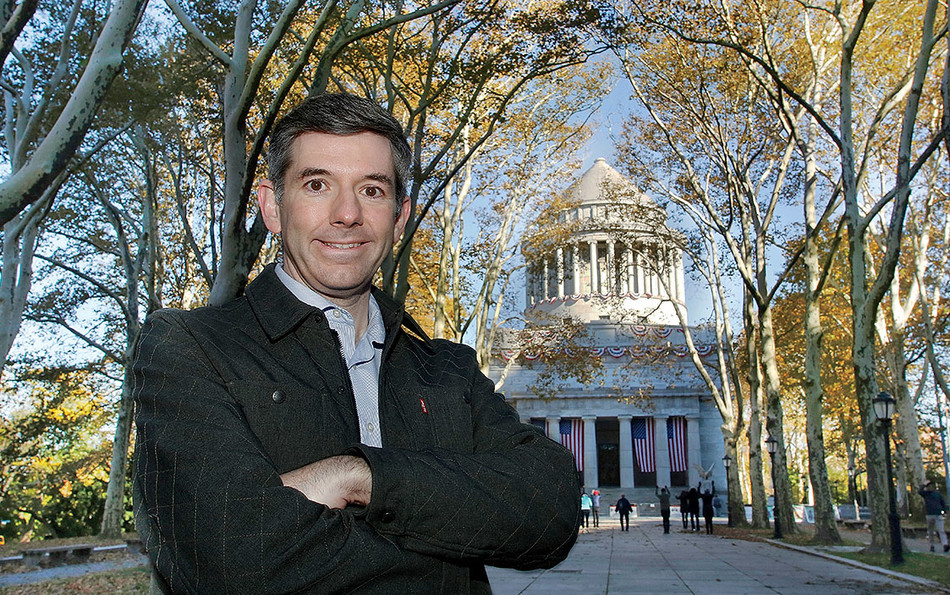Frank Scaturro ’94CC set down his suitcase in his freshman dorm and then walked up Riverside Drive to the General Grant National Memorial.
It was the fall of 1990, and Scaturro, a presidential-history buff from New Hyde Park, Long Island, was eager to visit Grant’s towering neoclassical mausoleum — the largest in the Western Hemisphere — to offer his services as a volunteer.
Scaturro had been fascinated with Ulysses S. Grant from childhood and knew that the monument, designed by John Duncan and managed since 1959 by the National Park Service, had fallen on hard times. Yet when he arrived at 122nd Street, he was shocked by what he saw. The crumbling outdoor plaza was marred by graffiti, littered with drug needles, and fouled by the stench of urine. Inside, the marble floors surrounding the sarcophagi of Grant and his wife, Julia Dent Grant, were cracked, and the captions for the photo exhibit contained several errors.
It was a bitter disappointment for Scaturro and an ugly end for the triumphant Union general and two-term president (1869 to 1877) who worked to secure civil rights for formerly enslaved people under the program of Reconstruction. When Grant died in 1885, his funeral procession in New York drew 1.5 million people, at the time the biggest gathering ever in North America. And in the first two decades after his privately funded monument was dedicated in 1897, Grant’s Tomb, as it was known, attracted more visitors than the Statue of Liberty.
Scaturro became a student volunteer and gave tours of the tomb on Grant’s birthday, April 27. A double major in history and political science, he wrote a paper reassessing Grant’s presidency, which he later expanded into a book called President Grant Reconsidered. “The condition of the tomb tracks with Grant’s seesawing reputation,” says Scaturro, who ascribes the decline to two forces: the narrative of the Lost Cause of the Confederacy, which whitewashed slavery and cast the South as the victim of Northern aggression; and the Dunning School, a white-supremacist reading of history articulated by Columbia professor William A. Dunning 1881CC, 1885GSAS, 1904HON, which discredited Reconstruction and gave cover to Jim Crow. In 1988, Scaturro’s faculty adviser, Eric Foner ’63CC, ’69GSAS, published the Bancroft Prize–winning Reconstruction: America’s Unfinished Revolution, 1863–1877, which provided a corrective to Dunning and a basis for Scaturro’s work on Grant.
“As president, Grant wanted to protect the gains of the Civil War,” Scaturro says. “He ensured the ratification of the Fifteenth Amendment [which made it illegal to deny the right to vote based on race], established the Department of Justice, and signed the Civil Rights Act of 1875. Tragically, much of this didn’t stick. The legal architecture of civil rights was dismantled during Jim Crow. But after the civil-rights movement, which in many ways recovered the principles of Reconstruction, Grant’s contributions were newly appreciated.”
While a student, Scaturro urged the Park Service to address the shabbiness of the national monument dedicated to the eighteenth president. He sent memos to his supervisors but got nowhere. Finally, he wrote a blistering report and sent it to everyone from President Bill Clinton and Secretary of the Interior Bruce Babbitt on down. In November 1993, after the local news reported on Scaturro’s campaign, the Park Service relieved him of his volunteer duties.
Scaturro fought on. He revived the Grant Monument Association, the group that built the edifice, and invited Grant’s descendants onto the board. Then, on January 2, 1994, the day Scaturro’s father died, the New York Times published an editorial titled “Dishonor for a Hero President,” which hailed Scaturro’s efforts. That same year, the association prepared a lawsuit to compel the US to restore the site, and a New York congressional delegation led by Representative Jerrold Nadler ’69CC, whose district included the monument, pushed for appropriations.
All of this spurred Congress to find the money. Security at the monument was beefed up, the structure was cleaned, and the plaza was replaced, all in time for the tomb’s centennial in 1997.
This spring marks 125 years since the tomb was unveiled, an anniversary that coincides with the bicentennial of Grant’s birth. Scaturro, now a lawyer, is working with the US Military Academy at West Point to organize events at the tomb for April 27, including a color guard, speeches, and a wreath-laying ceremony.
“There are only a few presidents you can call great,” Scaturro says, “and I think Grant is one of them.”



